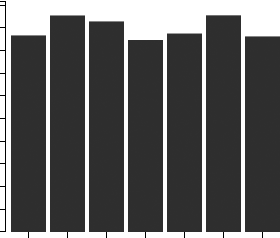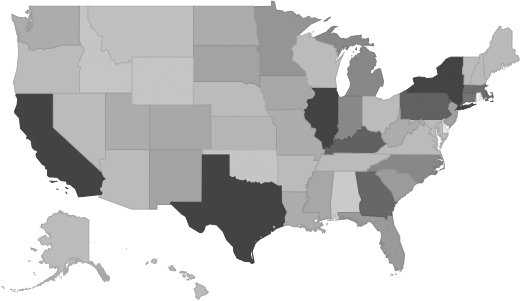Community Housing Services - Market Size, Financial Statistics, Industry Trends
Industry Overview
This industry comprises establishments primarily engaged in providing one or more of the following community housing services: (1) short-term emergency shelter for victims of domestic violence, sexual assault, or child abuse; (2) temporary residential shelter for the homeless, runaway youths, and patients and families caught in medical crises; (3) transitional housing for low-income individuals and families; (4) volunteer construction or repair of low-cost housing, in partnership with the homeowner who may assist in construction or repair work; and (5) repair of homes for elderly or disabled homeowners. These establishments may operate their own shelter, they may subsidize housing using existing homes, apartments, hotels, or motels, or they may require a low-cost mortgage or work (sweat) equity. Cross-References.Source: U.S. Census Bureau
Community Housing Services Market Size
This report includes historical and forecasted market sizes and industry trends for Community Housing Services. It reveals overall market dynamics from 2020 through the present, and predicts industry growth or shrinkage through 2030. Revenue data include both public and private companies in the Community Housing Services industry.| Historical | Forecasted | ||||||||||
|---|---|---|---|---|---|---|---|---|---|---|---|
| 2020 | 2021 | 2022 | 2023 | 2024 | 2025 | 2026 | 2027 | 2028 | 2029 | 2030 | |
| Market Size (Total Revenue) | Included in Report |
||||||||||
| % Growth Rate | |||||||||||
| Number of Companies | |||||||||||
| Total Employees | |||||||||||
| Average Revenue per Company | |||||||||||
| Average Employees per Company | |||||||||||
Industry Revenue ($ Billions)

Industry Forecast ($ Billions)

Pell Research's advanced econometric models forecast five years of industry growth based on short- and long-term trend analysis. Market size statistics include revenue generated from all products and services sold within the Community Housing Services industry.
Geographic Breakdown by U.S. State
Community Housing Services market share by state pinpoints local opportunities based on regional revenue statistics. Growth rate for each state is affected by regional economic conditions. Data by state can be used to locate profitable and nonprofitable locations for Community Housing Services companies in the United States.Industry Revenue by State [Sample]

Distribution by Company Size
| Company Size | All Industries | Community Housing Services |
|---|---|---|
| Small Business (< 5 Employees) | Included |
|
| Small Business (5 - 20) | ||
| Midsized Business (20 - 100) | ||
| Large Business (100 - 500) | ||
| Enterprise (> 500) | ||
Industry Income Statement (Average Financial Metrics)
Financial statement analysis determines averages for the following industry forces:- Cost of goods sold
- Compensation of officers
- Salaries and wages
- Employee benefit programs
- Rent paid
- Advertising and marketing budgets
The report includes a traditional income statement from an "average" Community Housing Services company (both public and private companies are included).
| Industry Average | Percent of Sales | |
|---|---|---|
| Total Revenue | Included |
|
| Operating Revenue | ||
| Cost of Goods Sold (COGS) | ||
| Gross Profit | ||
| Operating Expenses | ||
| Operating Income | ||
| Non-Operating Income | ||
| Earnings Before Interest and Taxes (EBIT) | ||
| Interest Expense | ||
| Earnings Before Taxes | ||
| Income Tax | ||
| Net Profit | ||
Average Income Statement

Cost of Goods Sold
Salaries, Wages, and Benefits
Rent
Advertising
Depreciation and Amortization
Officer Compensation
Net Income
Financial Ratio Analysis
Financial ratios allow a company's performance to be compared against that of its peers.| Financial Ratio | Industry Average |
|---|---|
| Profitability Ratios | Included |
| Profit Margin | |
| ROE | |
| ROA | |
| Liquidity Ratios | |
| Current Ratio | |
| Quick Ratio | |
| Activity Ratios | |
| Average Collection Period | |
| Asset Turnover Ratio | |
| Receivables Turnover Ratio | |
| Inventory Conversion Ratio |
Products and Services Mix
Product lines and services in the Community Housing Services industry accounting for the largest revenue sources.| Product Description | Description | Revenue ($ Millions) |
|---|---|---|
| Industry total | Included |
|
| Contributions, gifts, & grants - private | ||
| Contributions, gifts, & grants - government | ||
| Social assistance related to shelter for the general population | ||
| Transitional housing services | ||
| All other revenue | ||
| Temporary shelter services for the homeless | ||
| Investment income, including interest & dividends | ||
| Volunteer housing services | ||
| All other operating receipts | ||
Compensation and Salary Surveys
Salary information for employees working in the Community Housing Services industry.| Title | Percent of Workforce | Bottom Quartile | Average (Median) Salary | Upper Quartile |
|---|---|---|---|---|
| Management Occupations | 12% |
Included |
||
| Chief Executives | 1% | |||
| General and Operations Managers | 3% | |||
| Other Management Occupations | 6% | |||
| Business and Financial Operations Occupations | 8% | |||
| Business Operations Specialists | 6% | |||
| Community and Social Service Occupations | 30% | |||
| Counselors, Social Workers, and Other Community and Social Service Specialists | 30% | |||
| Social Workers | 8% | |||
| Child, Family, and School Social Workers | 5% | |||
| Miscellaneous Community and Social Service Specialists | 17% | |||
| Social and Human Service Assistants | 13% | |||
| Personal Care and Service Occupations | 10% | |||
| Other Personal Care and Service Workers | 9% | |||
| Residential Advisors | 5% | |||
| Residential Advisors | 5% | |||
| Office and Administrative Support Occupations | 14% | |||
| Transportation and Material Moving Occupations | 6% | |||
Government Contracts
The federal government spent an annual total of $76,373,652 on the Community Housing Services industry. It has awarded 872 contracts to 234 companies, with an average value of $326,383 per company.Top Companies in Community Housing Services and Adjacent Industries
| Company | Address | Revenue ($ Millions) |
|---|---|---|
Included |
||
